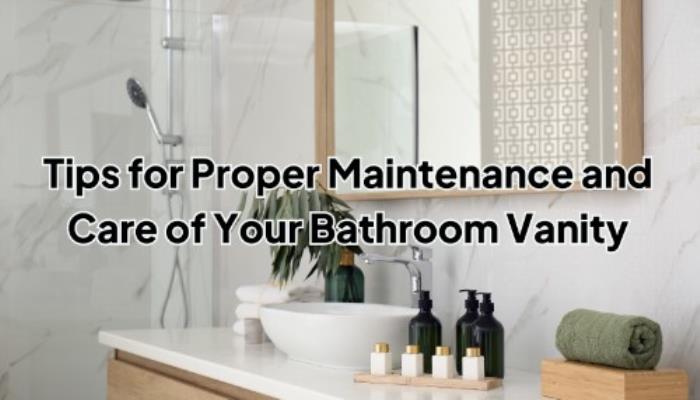Tips for Proper Maintenance and Care of Your Bathroom Vanity

Your bathroom vanity serves a dual purpose beyond mere functionality; it acts as a focal point that defines the ambiance of your entire bathroom. Regardless of whether you’ve opted for a lavish, upscale vanity or a simpler, more economical one, it’s crucial to prioritize maintenance and upkeep to safeguard its durability and retain its aesthetic allure over time. Failing to attend to routine maintenance tasks may result in noticeable deterioration, detracting from the vanity’s visual appeal and jeopardizing its long-term value. In the forthcoming discussion, we’ll delve into actionable advice and effective strategies aimed at preserving the pristine condition of your bathroom vanity.
Countertop Care
The surface that garners the most attention and undergoes the most extensive use within your bathroom setup is undeniably the countertop of the 30 bathroom vanity. This prominence not only makes it the focal point of the space but also leaves it especially vulnerable to the marks of everyday life, including scratches, stains, and the general wear and tear that comes with regular use. Given this, it’s important to recognize that various countertop materials demand their unique care and upkeep strategies to maintain their beauty and functionality over time.
- When caring for countertops made of quartz or granite, it’s best to stick with cleaners that are pH-neutral and steer clear of rough scouring pads or strong chemicals, which could mar or scratch the finish. It’s also a good idea to apply a sealant regularly to shield against both stains and water damage.
- For maintaining laminate surfaces, a gentle soap mixed with water does the trick. Also, remember not to place hot items directly on them to avoid any change in color or shape.
- Wooden countertops demand a bit more attention. Opt for a cleaner and conditioner specifically designed for wood to maintain and safeguard its appearance. Keeping them away from too much water will also help in preventing the wood from expanding or cracking.
Cabinet Care
The cupboards in your dressing table don’t just serve a practical role; they also play a big part in how it all looks. It’s important to keep them clean and well-maintained to avoid any harm and to keep them appearing neat and new.
- To keep your wooden cabinets clean, make sure to dust them frequently using a soft, dry cloth to avoid any accumulation of dirt and particles. Every now and then, apply a wood cleaner and polish to maintain and safeguard the surface.
- When it comes to painted or laminate cabinets, opt for a mild all-purpose cleaner and steer clear of harsh sponges or scrubbers that might cause scratches. Promptly clean up any spills to prevent them from leaving stains or causing discoloration.
Hardware Maintenance
The fixtures on your bathroom vanity, like handles, grips, and joints, can gather dirt, water marks, and dullness as time passes. It’s crucial to clean them regularly and apply suitable lubrication to keep them working smoothly and looking as good as new.
- To clean metal fittings, opt for a soft metal cleaner or a simple mix of soap and water to eliminate any grime and bring back their luster. Steer clear of rough cleaning agents that could mar or lessen their gloss.
- On components such as hinges that move, dab on a bit of silicone lubricant now and then to keep them from sticking or making noise.
Caulk and Grout Maintenance
Moisture can seep into the junctions where your vanity connects with the wall, floor, or backsplash, causing mold, mildew, and even water damage. It’s important to routinely check and reapply caulk and grout in these areas to prevent such issues.
- Regularly check the caulk lines for any signs of cracking, separation, or color changes, and replace them as necessary to ensure a tight seal.
- Keep the grout lines clean by using a specialized grout cleaner or a mild mixture of warm water and baking soda on a regular basis. If the current grout becomes noticeably discolored or starts to degrade, think about regrouting.
Sink and Faucet Care
The sink and faucet see a lot of use, so they need regular cleaning and upkeep to stop mineral buildup, stains, and potential plumbing problems.
- If you have a porcelain or ceramic sink, go for a gentle cleaner and steer clear of harsh chemicals that could harm the smooth surface.
- For stainless steel sinks, opt for a cleaner specifically made for stainless steel and polish it to keep it shiny and ward off water spots or rust.
- Regularly wipe down your faucets using a gentle cloth and a mild soap mix to maintain cleanliness. For tough mineral buildup, opt for a vinegar solution or a specialized cleaner designed for faucets.
Proper Ventilation
It’s essential to have good airflow in your bathroom to avoid moisture buildup, which could cause problems like mold and damage to your vanity and other bathroom fixtures.
- Make sure your bathroom has proper ventilation, like a window or exhaust fan.
- Switch on the exhaust fan when showering or bathing and keep it running afterward to get rid of excess moisture.
- If you’re in a humid area or your bathroom lacks ventilation, think about getting a dehumidifier.
Protect Against Water Damage
Protecting your bathroom vanity from water damage is crucial for its durability. Implementing preventive steps can reduce the chances of expensive repairs or replacements.
- Place bath mats or towels to absorb extra water post-showers or baths, preventing puddles on the floor or splashes onto the vanity.
- Quickly clean up any spills to stop moisture from penetrating the cabinets or countertop.
- Think about applying a waterproof sealant to the back of the vanity, particularly if it’s situated against an outside wall or in a moisture-prone space.
Regular Inspections
Constantly checking your bathroom vanity can catch small issues before they turn into bigger headaches.
- Every few months, give it a detailed look-over for any signs of damage, wear, or water damage.
- Keep an eye out for any cracks, chips, or signs that the finish is coming off on the countertop, cabinets, or fixtures.
- Make sure everything is secure, like drawers, doors, or hinges, and make any necessary adjustments or tightenings.
Conclusion
By adhering to these suggestions and integrating constant upkeep tasks into your regular household duties, you can guarantee that your bathroom vanity retains its attractiveness and usefulness for an extended period. Don’t forget, that taking preventive measures and addressing any problems promptly can spare you from expensive fixes or replacements in the future. Show your vanity the proper care and consideration it merits, and it will persist in enhancing the visual charm and worth of your bathroom for years to come.
FAQs
How often should I clean my bathroom vanity?
Cleaning frequency depends on usage but aiming for a light clean once a week and a deeper clean once a month should keep your vanity in good shape.
What cleaning products are safe to use on my vanity?
Opt for mild, non-abrasive cleaners designed for your vanity’s specific material—whether it’s wood, marble, or laminate. Always check the manufacturer’s recommendations first.
Can water damage my bathroom vanity?
Yes, prolonged exposure to water, especially around the sink and countertop areas, can damage your vanity. Wipe up spills and splashes immediately to prevent water damage and protect the finish.



